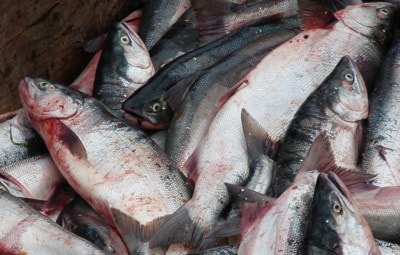Salmon farmers have agreed to provide fish samples to federal biologists who are investigating a newly detected virus they suspect is linked to the steep decline of wild sockeye.
The industry had previously refused to cooperate but four major aquaculture companies have now relented, the Cohen Inquiry heard Wednesday.
Dr. Kristi Miller, a genetics researcher with the Department of Fisheries and Oceans (DFO) in Nanaimo, said she wants to compare virus levels in wild sockeye with samples of farmed Atlantic salmon at various life stages – including juveniles before being placed in ocean net pens as well as later, when wild sockeye are passing the farms off northern Vancouver Island.
Miller testified she found wild sockeye salmon with a particular genetic signature are 13.5 times less likely to return to reach their spawning grounds than ones without the signature.
She said a parvovirus recently identified appears to be the likely culprit, but agreed with another DFO biologist that more research is needed to prove if it is actually infectious and causing lethal disease.
Miller said the virus "could be the smoking gun" that explains the premature deaths of millions of sockeye in recent years although another DFO researcher, Dr. Kyle Garver, said it is "pure speculation" to read too much into the findings yet.
Miller maintained she believes some pathogen, likely a virus, is harming salmon before they enter the Fraser River and contributing to an extremely high pre-spawn death rate.

"Fish were already compromised before they entered the river," she said, adding that proves river conditions alone cannot explain the sockeye decline.
Tests of farmed salmon may not bring back conclusive results on their potential role in time for the inquiry to factor them into its findings.
But under cross-examination by a lawyer for the salmon farming industry, Miller confirmed her data showed the highest level of the mortality marker was in young smolts that had not left the river and had not yet gone anywhere near fish farms, casting doubt on how they could play a major role.
"The main time period of transmission appears to be in fresh water," she said, adding it'
s been detected in young fry in their birth lakes.
Miller said that doesn't mean the virus didn't first originate with the fish farms nor does it exclude the potential for farmed fish – or perhaps other species in fresh water – to pass the virus back and forth with wild salmon.
She also confirmed the lethal signature has also been found in sockeye from Haida Gwaii, far from the fish farms, as well as sockeye from rivers on the west side of Vancouver Island, which don't migrate through Johnstone Strait.
Her group has done little research so far on northern stocks that return to the Skeena or Nass rivers.
Miller did stress the lethal markers were not found in the thriving Harrison Lake sockeye – which spend less time in fresh water and migrate around the west coast of Vancouver Island, not past the Johnstone Strait fish farms.
"Harrison is the one stock on the Fraser River that is increasing in productivity," she said.
"The fish that spend less time in fresh water tend to be doing better than the fish that spend more."
The possible spread of disease and the potential role of the aquaculture industry has been the focus of the commission this week.
Miller's appearance was widely anticipated due to reports she'd been muzzled by federal officials after the publication of her latest paper in the journal Science.
She told the commission she had been told not to publicly discuss her findings ahead of her testimony – out of respect for the inquiry – but said the same instructions applied to other DFO staff.
Miller said she has always had complete freedom to publish her findings.
"I've never been told not to share research."
Earlier in the week, the inquiry released emails from Miller in late July questioning why DFO wouldn't test farmed salmon for the parvovirus strain showing up in sockeye and warning colleagues the department better have an answer when the topic came up before the inquiry.
Miller's email indicated her colleagues felt there was no benefit to testing, and if the industry likely wouldn't comply if asked to voluntarily submit fish for testing.
The judicial inquiry led by retired Judge Bruce Cohen was called by the federal government after less than 1.5 million sockeye returned in 2009, far fewer than the more than 10 million expected.
The inquiry has explored myriad potential causes for the decline – from pollution and habitat destruction to overfishing and marine predators – but none has yet emerged as the probable sole cause of the drop in stocks.
